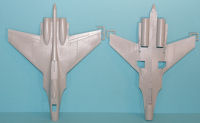
Hasegawa 1/72 Su-33 Flanker D Kit First Look
By Michael Benolkin
| Date of Review | April 2011 | Manufacturer | Hasegawa |
|---|---|---|---|
| Subject | Su-33 Flanker D | Scale | 1/72 |
| Kit Number | 01565 | Primary Media | Styrene |
| Pros | Very nice detailing | Cons | Nothing noted |
| Skill Level | Basic | MSRP (USD) | $54.95 |
First Look
 |
 |
 |
 |
 |
Soviet Naval Aviation was primarily a ground-based service for its fixed-wing aircraft throughout most of its history because the Soviet Navy didn't have aircraft carriers. Technically, the Russian Navy still doesn't own any aircraft carriers because of the Turkish ban on aircraft carriers transiting the Turkish straits that connect the Black Sea with the Mediterranean Sea. The Russians classify their VSTOL carriers as cruisers and their sole aircraft carrier Kuznetsov as a heavy aircraft-carrying cruiser.
During the peak of the Cold War, the Soviet Navy operated the Yak-38 Forger on their 'through-deck cruisers' while pushing for an angle-deck carrier capable of operating more conventional tactical aircraft. That vision came to pass with the start of construction of their first 'aircraft carrier' in 1982 and its commissioning in 1991. Some of the delay in getting this ship to sea may have been because of the numerous name changes (Riga => Brezhnev => Tblisi => Kuznetsov). One of the distinctive differences between Kuzetsov and other aircraft carriers is on the flight deck. While the Kuznetsov employs arresting gear similar to other carriers, the ship doesn't have catapults. Instead the naval designers took a page from the British and employ a ski-jump to get the aircraft airborne. This has the advantage of eliminating the complexities of catapults on the ship's design and the corresponding weight and complexity for catapult use on the aircraft.
In parallel with the development of the aircraft carrier, the major design bureaus evaluated their aircraft to determine suitability for carrier operations. Most Soviet tactical aircraft already have rugged landing gear and the associated airframe structures for operations from unimproved airfields. Key attributes include low-speed handling, stall speeds at different combat loads, over-the-nose visibility, and effective combat radius. A number of existing aircraft were evaluated and many showed promise, but the three that made it to the flight deck were variations of the Su-27, Su-25, and MiG-29.
The Su-33 (NATO Codename: Flanker D) is the result of a number of modifications applied to the Su-27 for carrier suitability. These modifications include: folding wings; upgraded landing gear; and arresting gear (tail hook). The Su-33 also received several airframe updates applied to the second generation Flankers including those canards. The Su-33 would go on to serve aboard Kuznetsov while the navalized MiG-29 (MiG-29K) would be selected for India's aircraft carrier. Flight operations aboard Kuznetsov aren't uneventful as seen here on YouTube:
While several model companies have released kits of the Su-33, Hasegawa has stepped up to the plate with the best of them all. You might think this is merely an update to their outstanding Su-27 kit, but you'd be incorrect. This new-tool kit shows that Hasegawa is still in the game to win.
Molded in light gray styrene, this kit is presented on six parts trees plus a single tree of clear parts. I love the clear tree as it has major clear walls surrounding the canopy and windscreen parts to protect them from damage.
Looking over the model, it is clear that Hasegawa did their homework. The airframe captures numerous distinctive details:
- Wing fold detail including the flaps
- Horizontal stabilizer fold details
- Extended forward chine with canards
- Short beaver tail with tail hook
- Corrected radome
- Molded-in air refueling probe
- Twin-wheel nose gear
Among the features in this kit:
- Nice cockpit
- Positionable canopy
- Positionable canards
- Positionable speed brake
Weapons options include:
- 4 x B-8 rocket pods
- 2 x VER racks for rocket pods
- 2 x R-27ET Alamo
- 4 x R-27R Alamo
- 2 x R-60 Aphid
- 4 x R-73 Archer
- 2 x R-77 Adder
The kit provides marking options for four aircraft:
- Su-33, Bort 60 (Hawk art)
- Su-33, Bort 72
- Su-33, Bort 80 (Tiger art)
- Su-33, Bort 81
The decals provide basic airframe stenciling as well as training round stripes for the R-73 missiles. For more marking options, check out the Begemot Su-33 decal sheet here. Hasegawa provides the camouflage colors in Gunze Sango Mr Hobby (Aqueous) and Mr Color recommendations.
This is a really nice looking kit that isn't complex, so this should be an easy build for most modelers. The Flankers have always had some interesting color schemes but the Sea Flankers are especially eye-catching with their blue camouflage patterns. This will be a fun build for the average modeler and provide some interesting opportunities for the AMS modeler that will want to do that little bit of surgery to fold the wings and stabs as well as drop in a resin cockpit. Either way, this Su-33 kit is a welcome addition to scale flight lines everywhere.
My sincere thanks to Hasegawa USA for this review sample!







